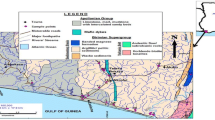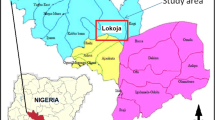Abstract
The Ganges River water and riverbank shallow groundwater were studied during a single wet season using the hydrochemical and isotopic composition of its dissolved load. The dissolved concentrations of major ions (Cl−, SO4 2−, NO3 −, HCO3 −, Ca2+, Na+, Mg2+, and K+), trace elements (barium (Ba) and strontium (Sr)) and stable isotopes (O and D) were determined on samples collected from the Ganges River and its riverbank shallow aquifers. In the present study, the shallow groundwater differs significantly from the Ganges River water; it shows distinct high concentrations of Ca2+, Mg2+, HCO3 −, Ba, and Sr due to water–rock interaction and this in particular suggests that the Ganges River may not contribute significantly to the riverbank shallow aquifers during wet season. Besides, the sum of the total cationic charge (∑+, in milliequivalents per liter) in the groundwater shows high values (2.48 to 13.91 meq/L, average 9.12 meq/L), which is much higher than the sum of the cations observed in the Ganges water (1.36 to 3.10 meq/L, average 1.94 meq/L). Finally, the more depleted stable isotopic (δ 18O and δ 2H) compositions of the Ganges River water are in contrast to those of the riverbank aquifer having enriched stable isotopic values during the wet season and the riverbank groundwater thus has a purely local origin from precipitation.





Similar content being viewed by others
References
Aggarwal PK, Basu AR, Kulkarni KM, Froehlich K, Tarafdar SA, Ali M, Hussain A (2000) A report on isotope hydrology of groundwater in Bangladesh: implications for characterization and mitigation of arsenic in groundwater. International Atomic Energy Agency-TC project BGD/8/016
Barth SR (2000) Stable isotope geochemistry of sediment-hosted groundwater from a late Paleozoic–early Mesozoic section in central Europe. J Hydrol 235:72–87
Bohlke JK, Horan M (2000) Strontium isotope geochemistry of groundwaters and streams affected by agriculture, Locust Grove, MD. Appl Geochem 15:599–609
Brammer H (1990) Floods in Bangladesh. I. Geographical background to the 1987 and 1988 floods. Geogr J 156:12–212
Carrillo-Rivera JJ, Varsányi I, Kovács LÓ, Cardona A (2007) Tracing groundwater flow systems with hydrogeochemistry in contrasting geological environments. Water Air Soil Poll 184:77–103
Coplen TB (1996) New guidelines for reporting stable hydrogen, carbon, and oxygen isotope-ratio data. Geoch et Cosmoch Acta 60:3359–3360
Craig H (1961) Isotopic variations in meteoric waters. Sci 133:1702–1703
Dowling CB, Poreda RJ, Basu AR (2003) The groundwater geochemistry of the Bengal basin: weathering, chemsorption, and trace metal flux to the oceans. Geoch et Cosmoch Acta 67:2117–2136
Gat JR, Tzur Y (1967) Modification of the isotopic composition of rainwater by processes which occur before groundwater recharge. Proceedings Symposium Isotopes in Hydrology. International Atomic Energy Agency, Vienna, pp. 49–60
Guglielmi Y, Mudry J, Blavoux B (1998) Estimation of the water balance of alluvial aquifers in region of high isotopic contrast: an example from southwestern France. J Hydrol 210:106–115
Huddard PA, Longstaffe FJ, Crowe AS (1999) dD and d18O evidence for inputs to groundwater at a wetland coastal boundary in the southern Great Lakes region of Canada. J Hydrol 214:18–31
Hunt R, Bullen TD, Krabbenhoft DP, Kendall C (1998) Using stable isotopes of water and strontium to investigate the hydrology of a natural and a constructed wetland. Groundwater 36:434–443
Kendall C, McDonnell JJ (1988) Isotope tracers in catchment hydrology. Elsevier, Amsterdam, p 839
Khan FH (1991) Geology of Bangladesh. University Press Limited, Dhaka
Kinniburgh DG, Smedley PL (2001) Final report. In: Arsenic contamination of groundwater in Bangladesh, vol. 2. Technical report WC/00/19
Lambs L (2000) Correlation of conductivity and stable isotope 18O for the assessment of water origin in river system. Chem Geol 164:61–170
Lambs L (2004) Interactions between groundwater and surface water at river banks and the confluence of rivers. J Hydrol 288:312–326
Leonhard P, Pepelnik R, Prange A, Yamada N, Yamada T (2002) Analysis of dilute sea-water at the ng L−1 level using an ICP-MS with an octopole reaction cell. J Anal At Spectrum 17:189–196
Majumder RK, Halim MA, Saha BB, Ikawa R, Nakamura T, Kagabu M, Shimada J (2011) Groundwater flow system in Bengal Delta, Bangladesh revealed by environmental isotopes. Environ Earth Sci 64:1343–1352
Meybeck M (1986) Composition chimique des ruisseaux non pollue´s de France. Sci Geol Bull 39:3–77
Moore WS (1997) High fluxes of radium and barium from the mouth of the Ganges-Brahmaputra river during low river discharge sugigest large groundwater source. Earth Plan Sci Lets 150:141–150
Négrel P, Lachassagne P (2000) Geochemistry of the Maroni river (French Guiana) during the low water stage: implications for water-rock interaction and groundwater characteristics. J Hydrol 237:212–233
Négrela P, Petelet-Giraud E, Barbier J, Gautier E (2003) Surface water–groundwater interactions in an alluvial plain: chemical and isotopic systematics. J Hydrol 277:248–267
Woessner WW (2000) Stream and fluvial plain ground water interactions: rescaling hydrogeologic thought. Ground Water 38:423–429
Acknowledgments
The first author would like to acknowledge the Ministry of Education, Culture, Sports Science and Technology (MEXT), Japan for providing postgraduate scholarship during 2005 to 2008.
Author information
Authors and Affiliations
Corresponding author
Rights and permissions
About this article
Cite this article
Majumder, R.K., Halim, M.A., Shimada, J. et al. Hydrochemistry and isotopic studies to identify Ganges River and riverbank groundwater interaction, southern Bangladesh. Arab J Geosci 6, 4585–4591 (2013). https://doi.org/10.1007/s12517-012-0767-3
Received:
Accepted:
Published:
Issue Date:
DOI: https://doi.org/10.1007/s12517-012-0767-3




